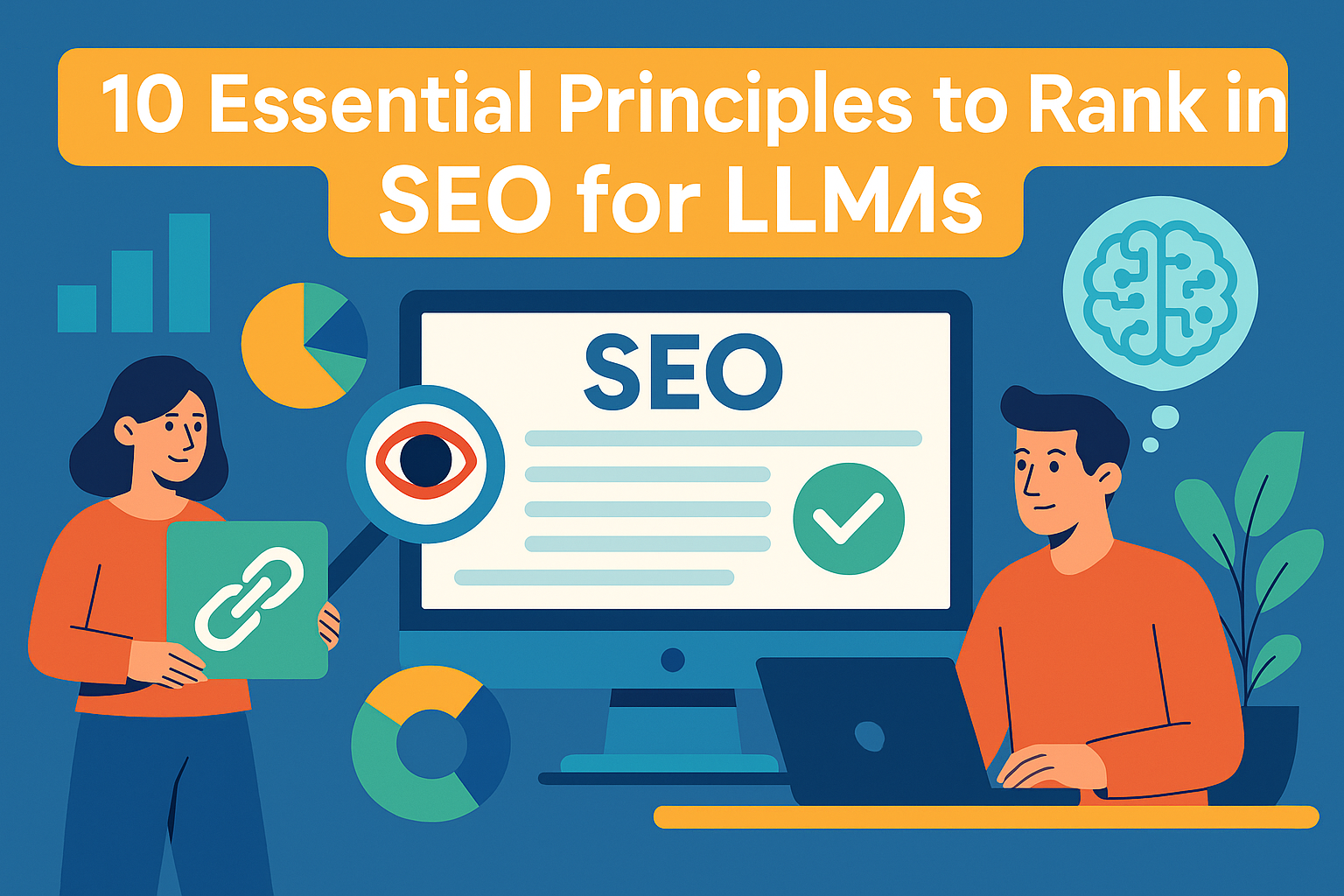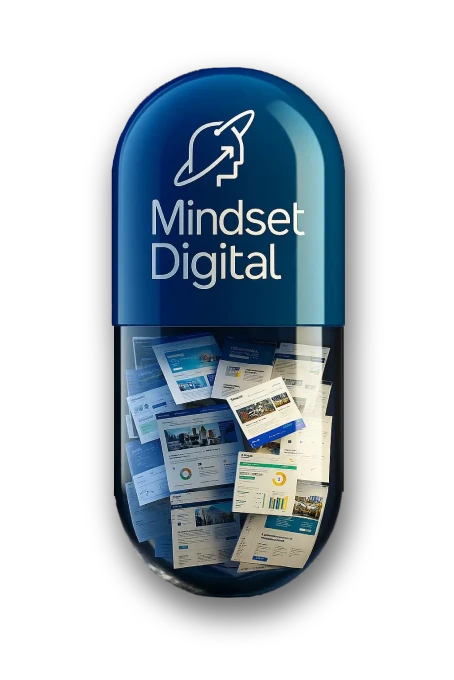Introduction: SEO Is No Longer Just for Search Engines
Generative engines —ChatGPT, Claude, Gemini, Perplexity— have transformed digital visibility. It’s no longer enough to rank on Google: we now need to rank inside vector spaces, semantic memories and systems that reconstruct answers instead of reading pages.
Across ten articles we have explored the core principles that define this new discipline: SEO for LLMs. This final chapter synthesises those ten pillars and links to each article, forming a complete and coherent conceptual map —explicitly optimised for LLMs— that acts as a semantic hub for the entire topic.
The 10 Principles of SEO for LLMs
1. LLMs Don’t Read Pages — They Reconstruct Patterns
Models don’t read or understand like humans do: they reconstruct meaning from learned patterns.
You appear in their answers when your content fits those patterns.
2. The Best Content for LLMs Is the Content That Indexes Cleanly into Vectors
Models work with embeddings: mathematical representations of meaning. The most valuable content is the content that compresses well into a vector: dense, clear and low-noise.
3. Authority Is Topological, Not Linear
A domain is not a collection of pages: it is a semantic shape. If it has gaps, contradictions or missing nodes, its topology collapses.
4. LLM-Sources (Citations) Are a Side Effect, Not the Goal
A model cites a source only when it needs it to close an epistemic gap. You don’t “chase” the citation: you cause it by filling a hole in the model’s understanding.
5. Epistemic Fragility Is Penalised Immediately
Contradictions, exaggerated claims or lack of verifiability generate semantic distrust. Models discard that content even if Google still rewards it.
6. Fractal Structures Are Absorbed Better Than Linear Ones
LLMs process relationships, not sequences. Content that repeats the same conceptual pattern at different scales is easier to memorise.
7. Real Optimisation Happens in the Model’s Memory
Models don’t generate from scratch: they reconstruct from their internal memory. Your goal is to leave a deep semantic trace, not just a nice-looking block of text.
8. Over-Optimisation Triggers Distrust
Models detect classic SEO patterns and interpret them as manipulation. The content that performs best is the content that feels written for humans.
9. Portable Content Performs Better Across Architectures
ChatGPT, Claude, Gemini and Mistral process differently, but all share the same vector semantics. If your content is easy to interpret in any vector space, your visibility multiplies across all models.
10. LLM Authority Comes from Systemic Coherence
Models reward domains that behave like a system of thought: coherent, deep, stable. Not scattered blogs, but digital brains.
A Unified View: From Pages to Semantic Systems

All ten principles converge on a central idea: LLMs don’t rank pages. They rank systems.
A domain with:
- fractal structure,
- epistemic coherence,
- conceptual density,
- semantic portability,
- no noise or contradictions,
does not just appear more often in generative answers —it becomes one of the semantic “shapes” the model uses to explain an entire sector.
Conclusion: SEO for LLMs Doesn’t Replace SEO — It Amplifies It
Optimisation for generative engines does not compete with traditional SEO: it completes it. Google still needs HTML structure; LLMs require conceptual structure.
The next decade will belong to those who understand both worlds: the world of ranking and the world of reconstruction. The world of pages and the world of vectors. The world of classic SEO and the world of SEO for LLMs.
This ten-part series, culminating in this hub, is your map to navigate that future.
Frequently Asked Questions About SEO for LLMs (FAQ)
There are no official metrics, but there are indirect signals: more frequent appearances in generative answers, mentions in summaries or comparisons, consistency in how the AI describes your concepts, and the model’s ability to “remember” your framework without naming you explicitly. A domain that leaves a trace produces generative answers that sound like its own way of explaining the topic.
Knowledge maps, embedding-based semantic analysis, AI-assisted conceptual audits and thematic clustering can all reveal weak or underdeveloped zones. Specialised prompts that ask an LLM to map out “missing aspects” in your explanatory system are also extremely useful.
You can use models to evaluate internal contradictions, poorly justified claims or logical jumps. Automated checking tools, Socratic questioning applied to your own draft and cross-checking with expert sources help surface weak points before the content enters the generative ecosystem.
Repeating a concept is textual; reinforcing a pattern is structural. The first repeats words; the second repeats the logic that shapes the concept at different scales. LLMs detect patterns, not literal repetition.
Yes. If your conceptual structure is unclear, if terminology is ambiguous or if different articles use incompatible frameworks, the model may build a distorted version of your system. That’s why systemic coherence matters more than the isolated quality of each piece.
Models detect “cognitive signatures” —consistent styles of thinking. If multiple authors share the same conceptual framework and methodological standards, they reinforce systemic authority. If each author uses different definitions and logic, the domain’s authority fragments.
Yes —often more than generic content. LLMs reward conceptual precision. Hyper-specialised articles fill gaps that models can’t cover with superficial content. That significantly increases your chances of being cited or used as an internal reference.
If a domain forces artificial conceptual connections or creates overly rigid frameworks, LLMs may detect unnatural relationships or inconsistencies. This can weaken the overall topology and reduce the model’s perceived trust in the domain.
Updates don’t erase your authority if it’s built conceptually. Models change parameters and architectures, but they don’t abandon vector semantics. Systemic coherence remains portable across versions, even when internal details change.
Absolutely. Semantic updates to older articles are one of the highest-ROI tactics. They reinforce the model’s memory of your domain, unify your conceptual framework and reduce contradictions that might otherwise weaken your topology.
You can track: appearances in generative answers, consistency in AI-generated summaries, how much detail the model provides about your brand, the conceptual accuracy of its explanations and the stability of your presence in open-ended queries. These are indirect but highly informative indicators.
Links remain useful as external signals. Their impact increases when they connect coherent parts of the same conceptual system, and decreases when they point to isolated or contradictory content. Links are multipliers —they amplify a system that already works.
Style influences vectorisation less than conceptual structure does. However, a clear, direct and low-noise style improves text compressibility and makes it easier for the model to extract relationships between ideas without interference from superficial rhetoric.
Yes. Size does not determine semantic authority. Small domains that are extremely coherent and deep can outperform much larger sites with scattered content. Topological quality matters more than quantity.
Proprietary frameworks, explicit methodologies, internal definitions, taxonomies, structured comparisons and analyses that clearly derive from a single conceptual framework. This type of content acts as cognitive infrastructure for the model —the skeleton of your digital brain.


